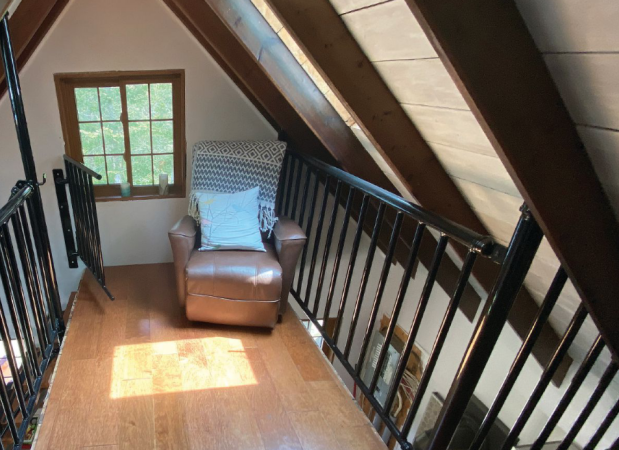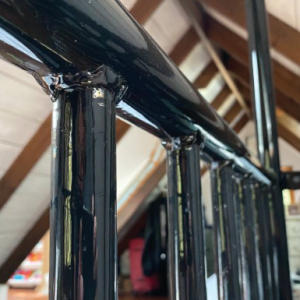
By Steve Maxwell
Black Gold – Using black iron pipe to create great looks
Canadian Contractor black iron pipe canada contractor finishing maxwellSinging the praises of black iron pipe as a great finishing material.
As a contractor you use different kinds of raw materials all the time. Lumber, sheet goods, shingles and paint are common, but you’ve probably missed at least one excellent raw building material until now. Black iron pipe is widely available, economically priced and relatively easy to work with. I’ve used this stuff for years on my projects and it makes strong and attractive railings for stairs, landings and balconies, plus light fixtures, handles, holders and posts. Black iron pipe is one of my favourite materials and it might become yours because it looks so good and can do so many things.
What is black iron pipe?
This stuff is actually made of steel not iron. It’s an uncoated commodity product that comes in common diameters from 1/2 to two inches and lengths up to 21 feet. The black colour comes from the manufacturing process at the mill. All black iron pipe uses the same threaded fittings as galvanized steel pipe, but the absence of zinc coating makes black iron easier to weld and finish.
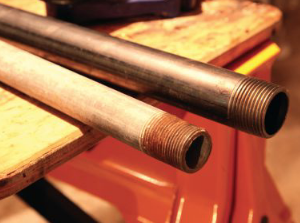
Black iron (right) is different from galvanized pipe because it’s uncoated and therefore easier to weld and finish.
Common black iron fittings include everything you’d expect when it comes to pipes: 45- and 90-degree elbows, couplers, unions, Ts, Ys, four-way fittings, valves and plugs. These fittings thread onto each other and to the pipe itself. Pipes and fittings usually come with threads already cut, though working with factory-cut threads is not the only way to go. Re-establishing threads on the ends of pipes after factory-threaded ends have been cut off is one of the more advanced techniques you can use with black iron pipe, as you’ll see.
Working with black iron pipe
To thread or not to thread, that is the question. The easiest way to begin working with black iron pipe is by not threading, using only standard lengths with pre-cut factory-threads. Home Hardware is one of the best places to get fittings and lengths of pre-threaded pipe from as short as a couple of inches up to eight feet long. This is where I buy most of mine. You can do a lot with off-the-shelf iron pipe and fittings, but there are three fabrication operations that you might consider adding to your repertoire if you find you like working with this stuff and want to use it more.
Clamping, cutting and threading
Black iron pipe is just about as soft as steel gets so it’s relatively easy to cut. I use either a hand-held metal-cutting bandsaw or when I want a crisper and more consistent cut end, a metal-cutting chopsaw. The thing about cutting pipe is that it usually leads to the need for more work. Cutting is great because it gives you exactly the length of pipe you need for a given application, but cutting pipe also removes any existing threads – threads that are one option for joining pipes and fittings. This is why more advanced users of black iron pipe often add two more skills to their capabilities: threading and welding pipe. With these skills in your lineup you can make many different things.
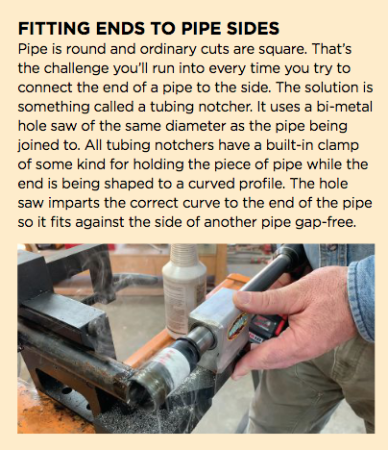 When it comes to threading pipe ends, there are two options: manual or electric. Both use the same dies to cut threads on the outside ends of the pipe, it’s just that electric threading is faster and easier. Electric threaders are expensive so you might consider going manual at first. Manual threaders are nothing more than a lever arm made to hold a pipe threading die. A ratcheting head on all manual threaders allows you to keep turning the die with the handle in the most convenient position. Mechanical threaders are simple and relatively inexpensive. If you ever have enough black iron work to justify buying an electric threader, the dies you’ve used with your manual threader will work fine. Either way, always use lots of cutting oil on the pipe as the pipe is being threaded to extend the life of the dies. I like to park my pipe vice over a garbage can while threading. This keeps excess oil off my shop floor but it also captures all the metal shavings created by threading.
When it comes to threading pipe ends, there are two options: manual or electric. Both use the same dies to cut threads on the outside ends of the pipe, it’s just that electric threading is faster and easier. Electric threaders are expensive so you might consider going manual at first. Manual threaders are nothing more than a lever arm made to hold a pipe threading die. A ratcheting head on all manual threaders allows you to keep turning the die with the handle in the most convenient position. Mechanical threaders are simple and relatively inexpensive. If you ever have enough black iron work to justify buying an electric threader, the dies you’ve used with your manual threader will work fine. Either way, always use lots of cutting oil on the pipe as the pipe is being threaded to extend the life of the dies. I like to park my pipe vice over a garbage can while threading. This keeps excess oil off my shop floor but it also captures all the metal shavings created by threading.
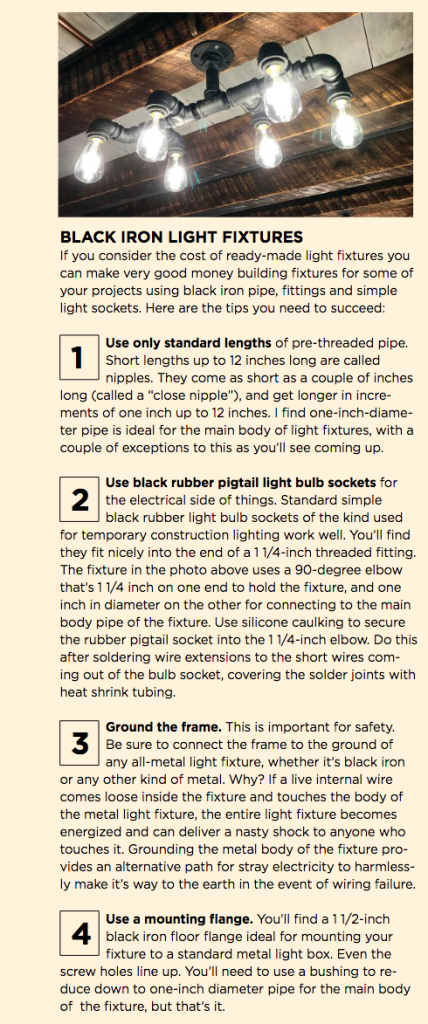 As you’d imagine, it takes a lot of strength to hold a round pipe steady while threading no matter how you do it. This is where a pipe vise can help. Mine is a simple, inexpensive unit I got on Amazon. It bolts to a hardwood platform that in turn gets held in the jaws of a portable workstation.
As you’d imagine, it takes a lot of strength to hold a round pipe steady while threading no matter how you do it. This is where a pipe vise can help. Mine is a simple, inexpensive unit I got on Amazon. It bolts to a hardwood platform that in turn gets held in the jaws of a portable workstation.
Welding black iron pipe
Black iron pipe welds nicely and welding is a skill that opens many creative possibilities. You don’t need to weld to make use of black iron pipe, but an electric welder of some kind can really help. I use a Lincoln gas-shielded MIG welder for my work welding pipes and it allows precise custom projects to be created, including complicated railings. Even a simple MIG welder costing less than $300 can open many possibilities for working with black pipe. Besides the pipes being easy to weld, so are the fittings. They take a weld bead beautifully and I’ve never had a fitting crack because it got too hot.
Planks, sheet goods, drywall, concrete – these are all the basics from which homes are built and renovated. Add a knowledge of black iron pipe to the mix and you can boost your profits and create homes and renovations that turn heads – all because you’ve used a cool material that few have thought of in this way.

